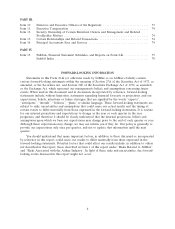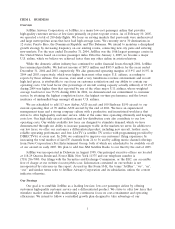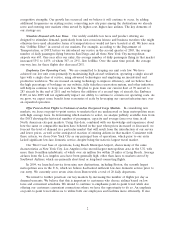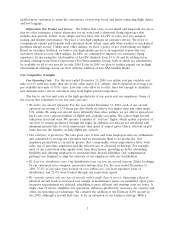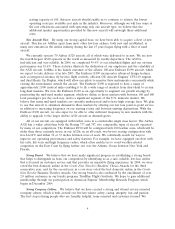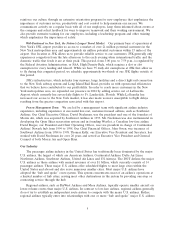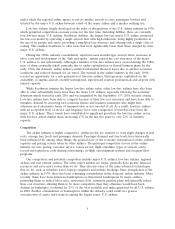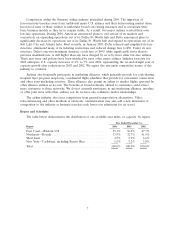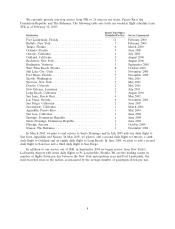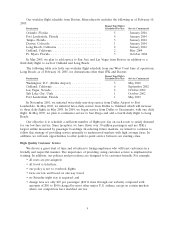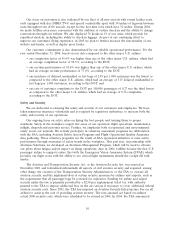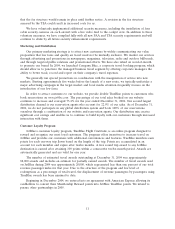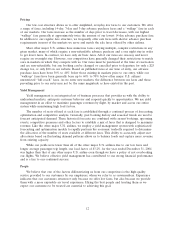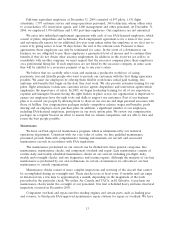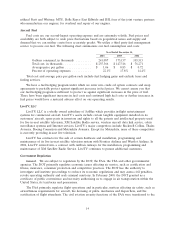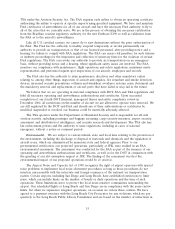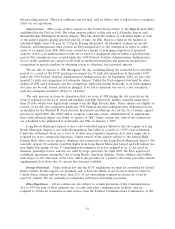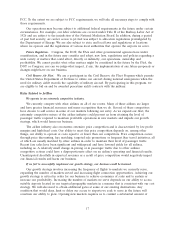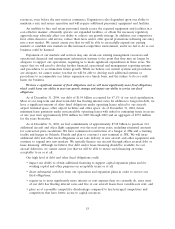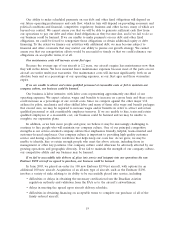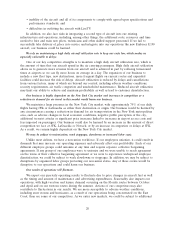JetBlue Airlines 2004 Annual Report Download - page 18
Download and view the complete annual report
Please find page 18 of the 2004 JetBlue Airlines annual report below. You can navigate through the pages in the report by either clicking on the pages listed below, or by using the keyword search tool below to find specific information within the annual report.Our focus on customers is also evidenced by our fleet of all new aircraft with roomy leather seats,
each equipped with free DIRECTV and spaced comfortably apart with 34 inches of legroom between
seats throughout our A320 aircraft, except for the first nine rows which have 32 inches. During 2004,
we made JetBlue even more convenient with the addition of on-line check-in and the ability to change
reservations through our website. We also deployed 76 kiosks in 19 of our cities, which provide for
expedited check-in, including the ability to check-in luggage. As part of our continuing effort to
improve our customers’ flying experience, in 2005 we plan to further increase the functionality of our
website and kiosks, as well as deploy more kiosks.
Our customer commitment is also demonstrated by our reliable operational performance. For the
year ended December 31, 2004, based on our data compared to the other major U.S. airlines:
• our completion factor of 99.4% was higher than any of the other major U.S. airlines, which had
an average completion factor of 98.3%, according to the DOT;
• our on-time performance of 81.6% was higher than any of the other major U.S. airlines, which
had an average on-time performance of 77.6%, according to the DOT;
• our incidence of delayed, mishandled or lost bags of 2.99 per 1,000 customers was the lowest as
compared to the other major U.S. airlines, which had an average of 5.15 delayed, mishandled or
lost bags per 1,000 customers, according to the DOT; and
• our rate of customer complaints to the DOT per 100,000 passengers of 0.27 was the third lowest
as compared to the other major U.S. airlines, which had an average of 0.76 complaints,
according to the DOT.
Safety and Security
We are dedicated to ensuring the safety and security of our customers and employees. We have
taken numerous measures, voluntarily and as required by regulatory authorities, to increase both the
safety and security of our operations.
Our ongoing focus on safety relies on hiring the best people and training them to proper
standards. Safety in the workplace targets five areas of our operation: flight operations, maintenance,
inflight, dispatch and customer service. Further, we emphasize both occupational and environmental
safety across our network. We actively participate in voluntary assessment programs in collaboration
with the FAA, including Aviation Safety Action Programs and Flight Operational Quality Assurance
data gathering. These voluntary programs are the result of FAA sponsored initiatives to raise safety
performance through awareness of safety trends in the workplace. This past year, in partnership with
Alertness Solutions, we developed an Alertness Management Program, which will be used to educate
our pilots about fatigue and its impact on flying operations. Also in 2004, JetBlue became the first U.S.
passenger airline to equip its entire fleet with the Emergency Vision Assurance System (EVAS), which
provides our flight crews with the ability to see critical flight instruments should the cockpit fill with
smoke.
The Aviation and Transportation Security Act, or the Aviation Security Act, was enacted in
November 2001 and federalized substantially all aspects of civil aviation security and required, among
other things, the creation of the Transportation Security Administration, or the TSA, to oversee all
aviation security, and the implementation of certain security measures by airlines and airports, such as
the requirement that all passenger bags be screened for explosives. Funding for airline and airport
security under the law is primarily provided by a $2.50 per enplanement ticket tax, with authority
granted to the TSA to impose additional fees on the air carriers if necessary to cover additional federal
aviation security costs. Since 2002, the TSA has imposed an Aviation Security Infrastructure Fee on all
airlines to assist in the cost of providing aviation security. The fees assessed are based on airlines’
actual 2000 security costs, which were scheduled to be revised in 2004. In 2004, the TSA announced
10


